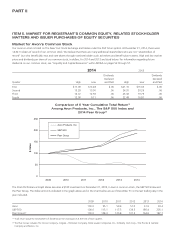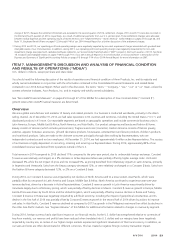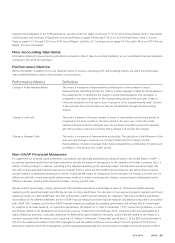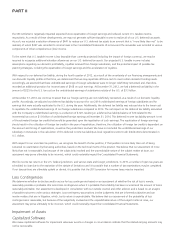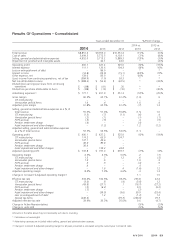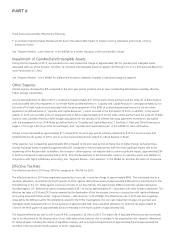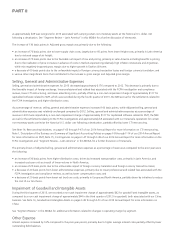Avon 2014 Annual Report Download - page 36
Download and view the complete annual report
Please find page 36 of the 2014 Avon annual report below. You can navigate through the pages in the report by either clicking on the pages listed below, or by using the keyword search tool below to find specific information within the annual report.PART II
For 2014, the weighted average assumed rate of return on all pension plan assets, including the U.S. and non-U.S. defined benefit pension
plans was 6.86%, compared with 7.19% for 2013. In determining the long-term rates of return, we consider the nature of the plans’
investments, an expectation for the plans’ investment strategies, historical rates of return and current economic forecasts. We evaluate the
expected long-term rate of return annually and adjust as necessary.
Beginning in 2014, we have adopted an investment strategy for the U.S. defined benefit pension plan which is designed to match the
movements in the pension liability through an increased allocation towards debt securities. In addition, we also have begun to utilize
derivative instruments to achieve the desired market exposures or to hedge certain risks. Derivative instruments may include, but are not
limited to, futures, options, swaps or swaptions. Investment types, including the use of derivatives are based on written guidelines
established for each investment manager and monitored by the plan’s management team. In 2015, similar investment strategies are
expected to be implemented in some of our non-U.S. defined benefit pension plans.
A significant portion of our pension plan assets relate to the U.S. defined benefit pension plan. The assumed rate of return for 2014 for the
U.S. defined benefit pension plan was 7.50%, which was based on an asset allocation of approximately 70% in corporate and government
bonds and mortgage-backed securities (which are expected to earn approximately 2% to 3% in the long term) and approximately 30% in
equity securities and high yield securities (which are expected to earn approximately 6% to 9% in the long term). In addition to the physical
assets, the asset portfolio has derivative instruments which increase our exposure to higher yielding securities. Historical rates of return on
the assets of the U.S. defined benefit pension plan were approximately 8% for the most recent 10-year period and approximately 9% for
the 20-year period. In the U.S. defined benefit pension plan, our asset allocation policy has historically favored U.S. equity securities, which
have returned approximately 8% over the 10-year period and approximately 10% over the 20-year period. The rate of return on the plan
assets in the U.S. was approximately 11% in 2014 and approximately 13% in 2013.
Regulations under the U.S. Pension Protection Act of 2006, which are finalized but not yet effective, will require that hybrid plans limit the
maximum interest crediting rate to one among several choices of crediting rates which are considered “market rates of return.” The rate
chosen will affect total pension obligations. The discount rate used for determining future pension obligations for each individual plan is
based on a review of long-term bonds that receive a high-quality rating from a recognized rating agency. The discount rates for our more
significant plans, including our U.S. defined benefit pension plan, were based on the internal rates of return for a portfolio of high quality
bonds with maturities that are consistent with the projected future benefit payment obligations of each plan. The weighted-average
discount rate for U.S. and non-U.S. defined benefit pension plans determined on this basis was 3.55% at December 31, 2014, and 4.56% at
December 31, 2013. For the determination of the expected rate of return on assets and the discount rate, we take external actuarial advice
into consideration.
Our funding requirements may be impacted by standards and regulations or interpretations thereof. Our calculations of pension and
postretirement costs are dependent on the use of assumptions, including discount rates, hybrid plan maximum interest crediting rates and
expected return on plan assets discussed above, rate of compensation increase of plan participants, interest cost, health care cost trend
rates, benefits earned, mortality rates, the number of participants and certain demographics and other factors. Actual results that differ from
assumptions are accumulated and amortized to expense over future periods and, therefore, generally affect recognized expense in future
periods. At December 31, 2014, we had pretax actuarial losses and prior service credits totaling $377 for the U.S. defined benefit pension
and postretirement plans and $341 for the non-U.S. defined benefit pension and postretirement plans that have not yet been charged to
expense. These actuarial losses have been charged to accumulated other comprehensive loss (“AOCI”) within shareholders’ equity. While we
believe that the assumptions used are reasonable, differences in actual experience or changes in assumptions may materially affect our
pension and postretirement obligations and future expense. For 2015, our assumption for the expected rate of return on assets is 7.25% for
our U.S. defined benefit pension plan and 6.55% for our non-U.S. defined benefit pension plans. Our assumptions are reviewed and
determined on an annual basis.




